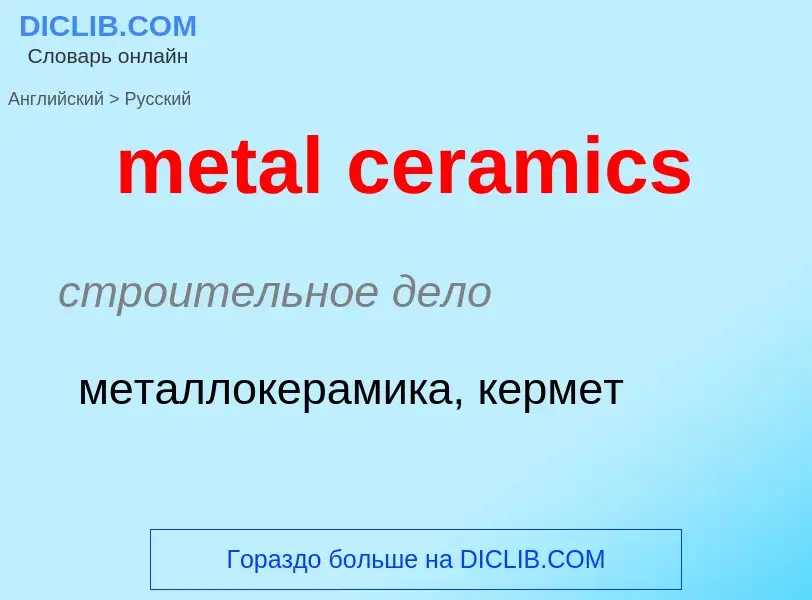Перевод и анализ слов искусственным интеллектом ChatGPT
На этой странице Вы можете получить подробный анализ слова или словосочетания, произведенный с помощью лучшей на сегодняшний день технологии искусственного интеллекта:
- как употребляется слово
- частота употребления
- используется оно чаще в устной или письменной речи
- варианты перевода слова
- примеры употребления (несколько фраз с переводом)
- этимология
metal ceramics - перевод на русский
строительное дело
металлокерамика, кермет
[si'ræmiks]
общая лексика
керамика
строительное дело
керамические изделия
строительная керамика
существительное
общая лексика
керамика
гончарное производство
употр. с гл. во мн. ч. керамические изделия
общая лексика
керамический материал
строительное дело
керамические материалы
[pɔt'metl]
общая лексика
медносвинцовый сплав
чугун для посудного литья
сленг
цветное стекло (окрашенное при варке)
[si'ræmik]
прилагательное
общая лексика
керамический
гончарный
Определение
Википедия
Deruta, a medieval hilltown in Umbria, Italy, is mainly known as a major centre for the production of maiolica (painted tin-glazed earthenware) in the Renaissance and later. Production of pottery is documented in the early Middle Ages, though no surviving pieces can be firmly attributed there before about 1490. It reached its artistic peak in the 15th and early 16th century.
It was the first Italian centre to use lustreware pigments, usually yellow, ruby or olive-green. Open pieces are usually only painted the top side; both of these suggesting influence from Spain. Deruta istoriato designs (with narrative scenes) are less common than single figures, usually no more than half-length, and in both cases the central painted design rarely covers the whole surface, leaving room for a generous border painted with decorative motifs.
In 1553, Leandro Alberti wrote “... the terracotta vases made in Deruta are often mentioned for how well they are made and beautifully decorated. And it is believed that there are no other craftsmen in Italy that can match the work even though there have been attempts to do so...” However, it was just at this point that the quality of wares began to decline.
Some individual painters are known, but at the same time it is often difficult to assign pieces between Derauta and other centres, especially nearby Gubbio.
A characteristic local motif is the Deruta trademark "Raffaellesco" dragon design, said to be inspired by the murals of Raphael. An example of this dragon in Raphael's work can be seen in the painting "St Michael Killing the Dragon".



![The [[Meissner effect]] demonstrated by levitating a magnet above a cuprate superconductor, which is cooled by [[liquid nitrogen]] The [[Meissner effect]] demonstrated by levitating a magnet above a cuprate superconductor, which is cooled by [[liquid nitrogen]]](https://commons.wikimedia.org/wiki/Special:FilePath/Magnet 4.jpg?width=200)
![diving watch bezel insert]] diving watch bezel insert]]](https://commons.wikimedia.org/wiki/Special:FilePath/Qimei watch on Zulu strap.jpg?width=200)

![Cutting disks made of [[silicon carbide]] Cutting disks made of [[silicon carbide]]](https://commons.wikimedia.org/wiki/Special:FilePath/Ultra-thin separated (Carborundum) disk.jpg?width=200)
![Earliest known ceramics are the [[Gravettian]] figurines that date to 29,000 to 25,000 BC. Earliest known ceramics are the [[Gravettian]] figurines that date to 29,000 to 25,000 BC.](https://commons.wikimedia.org/wiki/Special:FilePath/Vestonicka venuse edit.jpg?width=200)
.jpg?width=200)
![Normandie}}. The ''Queen Mary'' model has cracked in the bow due to [[zinc pest]]. Normandie}}. The ''Queen Mary'' model has cracked in the bow due to [[zinc pest]].](https://commons.wikimedia.org/wiki/Special:FilePath/Dinky liners with zinc pest.jpg?width=200)
